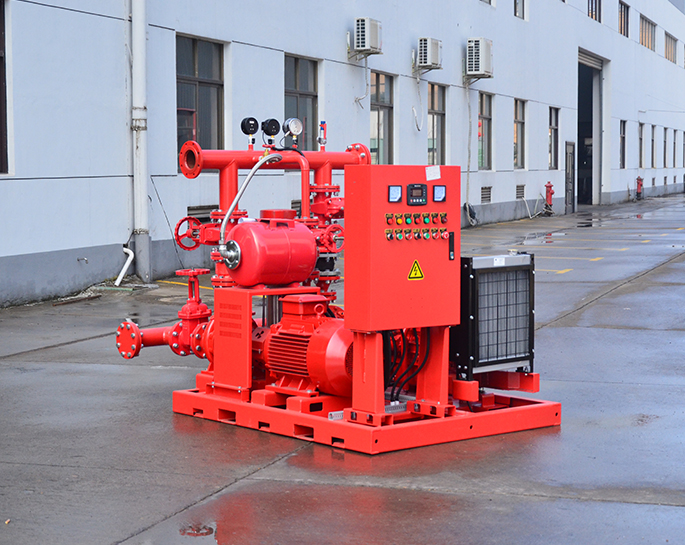What measures can be taken to enhance the energy efficiency of fire pump systems?
Jan 31, 2024
Share:
Enhancing the energy efficiency of fire pump systems is crucial for both environmental and economic reasons. Here are several measures that can be taken to improve the energy efficiency of fire pump systems:
1. **Variable Frequency Drives (VFDs):**
- Install Variable Frequency Drives on electric fire pumps to control the motor speed based on demand. This allows the pump to operate at optimal speeds, reducing energy consumption during periods of low demand.
2. **Regular Maintenance:**
- Conduct regular maintenance and testing of fire pump systems to ensure they are operating at peak efficiency. This includes checking for leaks, inspecting valves, and verifying that all components are in good working condition.
3. **Efficient Pump Design:**
- Choose pumps with efficient design features, such as impeller and volute shapes that minimize friction and turbulence. Selecting pumps with higher efficiency ratings can significantly reduce energy consumption.
4. **Proper Sizing:**
- Ensure that the fire pump is properly sized for the specific application. Oversized pumps can lead to energy wastage, as they may operate at partial load conditions, which is less efficient.
5. **Pressure Reducing Valves:**
- Implement pressure reducing valves to control excess pressure in the system. This helps to avoid unnecessary energy consumption and reduces wear on pump components.
6. **System Zoning:**
- Divide the fire protection system into zones and use multiple smaller pumps instead of one large pump. This allows for better control and optimization of energy usage based on the specific requirements of each zone.
7. **Energy-Efficient Motors:**
- Use energy-efficient motors for the fire pumps. High-efficiency motors can significantly reduce energy consumption compared to standard motors.
8. **Optimize Pipe Design:**
- Optimize the design of the piping system to minimize friction losses. Properly sized and configured pipes can reduce the energy required to move water through the system.
9. **Energy Recovery Systems:**
- Consider implementing energy recovery systems, such as regenerative braking, to capture and reuse energy during periods of reduced demand.
10. **Monitoring and Control Systems:**
- Implement advanced monitoring and control systems that can continuously assess the demand for water and adjust pump operation accordingly. This helps to prevent unnecessary energy consumption during periods of low demand.
11. **Training and Awareness:**
- Ensure that personnel responsible for operating and maintaining the fire pump system are well-trained. Awareness of energy-efficient practices and the importance of regular maintenance can contribute to optimal system performance.
By combining these measures, it is possible to enhance the energy efficiency of fire pump systems, ensuring they are both reliable and environmentally friendly.

1. **Variable Frequency Drives (VFDs):**
- Install Variable Frequency Drives on electric fire pumps to control the motor speed based on demand. This allows the pump to operate at optimal speeds, reducing energy consumption during periods of low demand.
2. **Regular Maintenance:**
- Conduct regular maintenance and testing of fire pump systems to ensure they are operating at peak efficiency. This includes checking for leaks, inspecting valves, and verifying that all components are in good working condition.
3. **Efficient Pump Design:**
- Choose pumps with efficient design features, such as impeller and volute shapes that minimize friction and turbulence. Selecting pumps with higher efficiency ratings can significantly reduce energy consumption.
4. **Proper Sizing:**
- Ensure that the fire pump is properly sized for the specific application. Oversized pumps can lead to energy wastage, as they may operate at partial load conditions, which is less efficient.
5. **Pressure Reducing Valves:**
- Implement pressure reducing valves to control excess pressure in the system. This helps to avoid unnecessary energy consumption and reduces wear on pump components.
6. **System Zoning:**
- Divide the fire protection system into zones and use multiple smaller pumps instead of one large pump. This allows for better control and optimization of energy usage based on the specific requirements of each zone.
7. **Energy-Efficient Motors:**
- Use energy-efficient motors for the fire pumps. High-efficiency motors can significantly reduce energy consumption compared to standard motors.
8. **Optimize Pipe Design:**
- Optimize the design of the piping system to minimize friction losses. Properly sized and configured pipes can reduce the energy required to move water through the system.
9. **Energy Recovery Systems:**
- Consider implementing energy recovery systems, such as regenerative braking, to capture and reuse energy during periods of reduced demand.
10. **Monitoring and Control Systems:**
- Implement advanced monitoring and control systems that can continuously assess the demand for water and adjust pump operation accordingly. This helps to prevent unnecessary energy consumption during periods of low demand.
11. **Training and Awareness:**
- Ensure that personnel responsible for operating and maintaining the fire pump system are well-trained. Awareness of energy-efficient practices and the importance of regular maintenance can contribute to optimal system performance.
By combining these measures, it is possible to enhance the energy efficiency of fire pump systems, ensuring they are both reliable and environmentally friendly.







